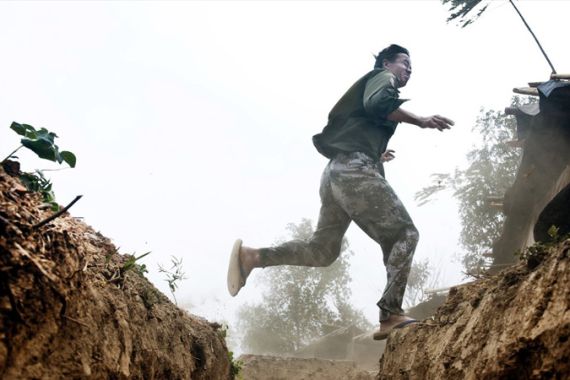On the front line with Kachin rebels
Fighting rages between Myanmar troops and Kachin Independence Army after a 17-year-long ceasefire was broken a year ago.

On a lonely mountaintop, at the front lines of the Kachin Independence Army (KIA), Third Brigade, a small group of soldiers, smoking cheroots and drinking homemade rice alcohol, take cover from the rain under a small tent.
They are the last line of defence for Mai Ja Yang, the second-largest town under KIA control, located in the eastern division of Myanmar’s northernmost state. For the time being, things are quiet, but fighting could erupt any time if government soldiers stationed at the next mountaintop launch an artillery attack.
KIA Major Kum Mai has been a soldier for 20 years, but hadn’t seen fighting until a 17-year ceasefire between the Kachin Independence Organisation (KIO) and the government unravelled one year ago.
Now, a year later, he can’t remember how many battles he’s fought. Kum Mai is “sorry about their living conditions”.
‘‘I’m worried about what is happening to our people. They don’t have enough food to eat,” he says.
According to a report by Human Rights Watch in late 2011, “Burma’s armed forces have committed serious abuses against ethnic Kachin. Burmese armed forces have been responsible for killings and attacks on civilians, using forced labour, and pillaging villages, which has resulted in the displacement of an estimated 30,000 Kachin civilians.”
Human Rights Watch now believes that number to be 75,000.
It is only a few hours away by motorcycle from Sang Gang, N’mawk (Momauk) Township, eastern Kachin state, where Burmese Battalions 437 and 438 attacked a strategic KIA post at about 3 pm on June 9, 2011, officially ending the ceasefire.
The KIO, the political wing of the KIA, was established on February 5, 1961. Initially the group wanted an independent homeland. But since 1975, it has been seeking autonomy for the Kachin people and a return to federalism promised under Myanmar independence leader Aung San, who was assassinated in 1947.
Broken promises
When the KIO and government agreed to a ceasefire in 1994, they were offered economic development for the region. They were promised discussions regarding autonomy, and that other rights would be forthcoming when a new constitution was drafted, after the country got an elected government.
In the meantime, the government sold off rights to timber and other valuable resources to Chinese companies and local businessmen, leading to widespread environmental degradation.
After the previous regime under the leadership of Than Shwe pushed the 2008 constitution through in the wake of Cyclone Nargis, all ceasefire groups were required to become Border Guard Forces for the Myanmar military. Pressing matters like autonomy and political reconciliation for the Kachin and other ceasefire groups were off the table.
Myanmar President Thein Sein ordered the military to stop attacking the KIA in early December. Fighting slowed a bit, but the order didn’t quell the conflict in Kachin and Shan states, where daily clashes are ongoing. The president’s critics claim Thein Sein’s real motivations weren’t to address the problems at the root of the conflict, but rather appear to look like he’s doing something in order to meet requirements imposed by Western governments before international sanctions could be lifted.
In the last year the government’s negotiating team, headed by Railways Minister Aung Min, has succeeded in achieving ceasefires with most of the minority armies, including the Karen National Union, who had been fighting against the government for 63 years.
But several meetings with the KIO over the last six months have failed to broker a new ceasefire.
Perhaps it is because the government has followed the same formula used during the previous ceasefire – false promises for economic development while demands for autonomy falling to deaf ears.
Last week during an informal meeting between the KIO and government negotiating team, Kachin leaders continued to press for government armed forces to withdraw from the frontlines, while government negotiators continued to advocate for a new ceasefire to be signed before serious discussions take place.
The year-old conflict is taking a toll on Kachin frontline soldiers like Kum Mai and his family.
He hasn’t seen his wife and six children for months, even though they live only one hour away. Kum Mai says he talks to them every day when there is a mobile signal. He hopes one day his only son will be able to do “whatever he wants in life”.
“I don’t want him to have to be a soldier.”